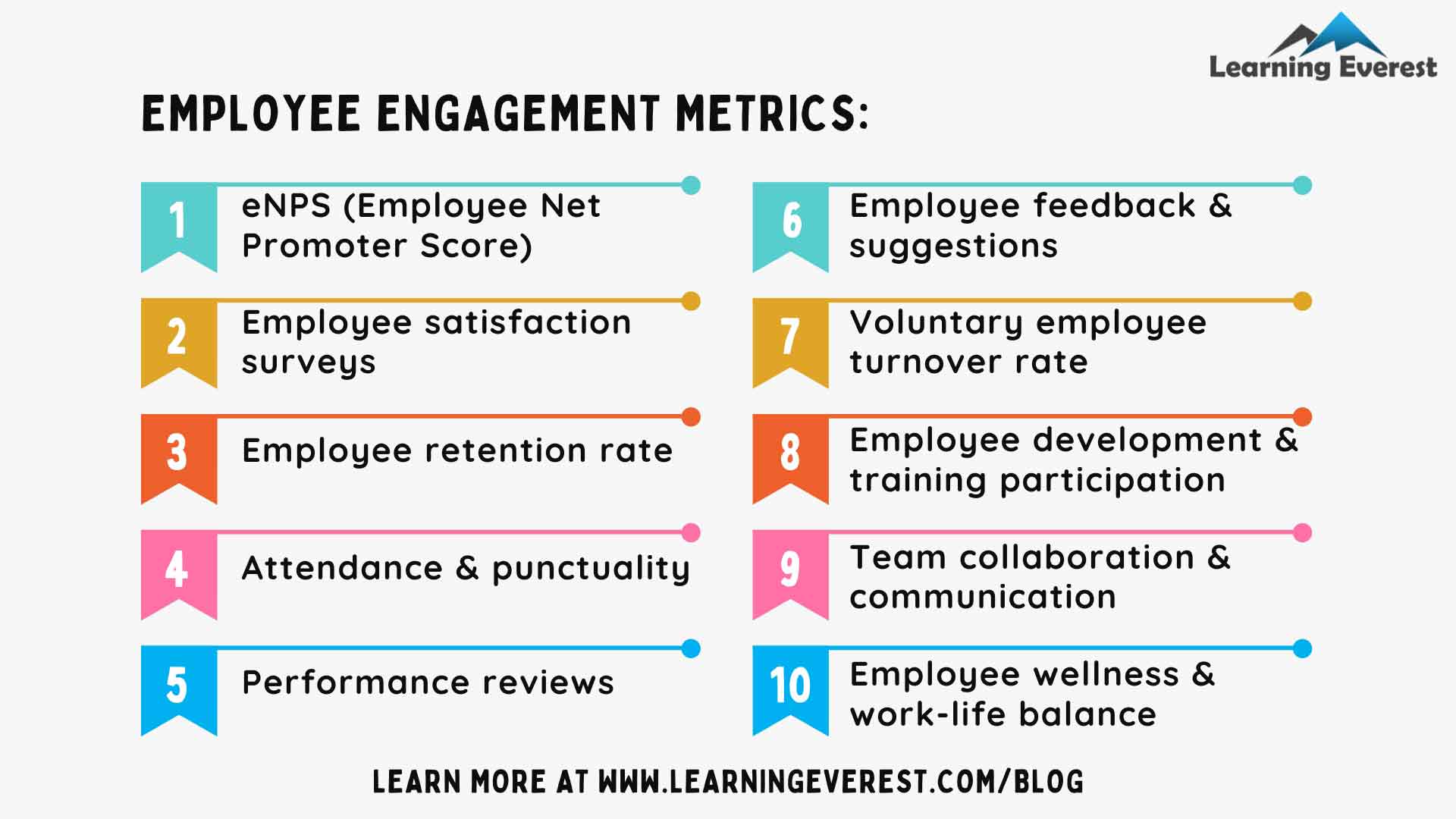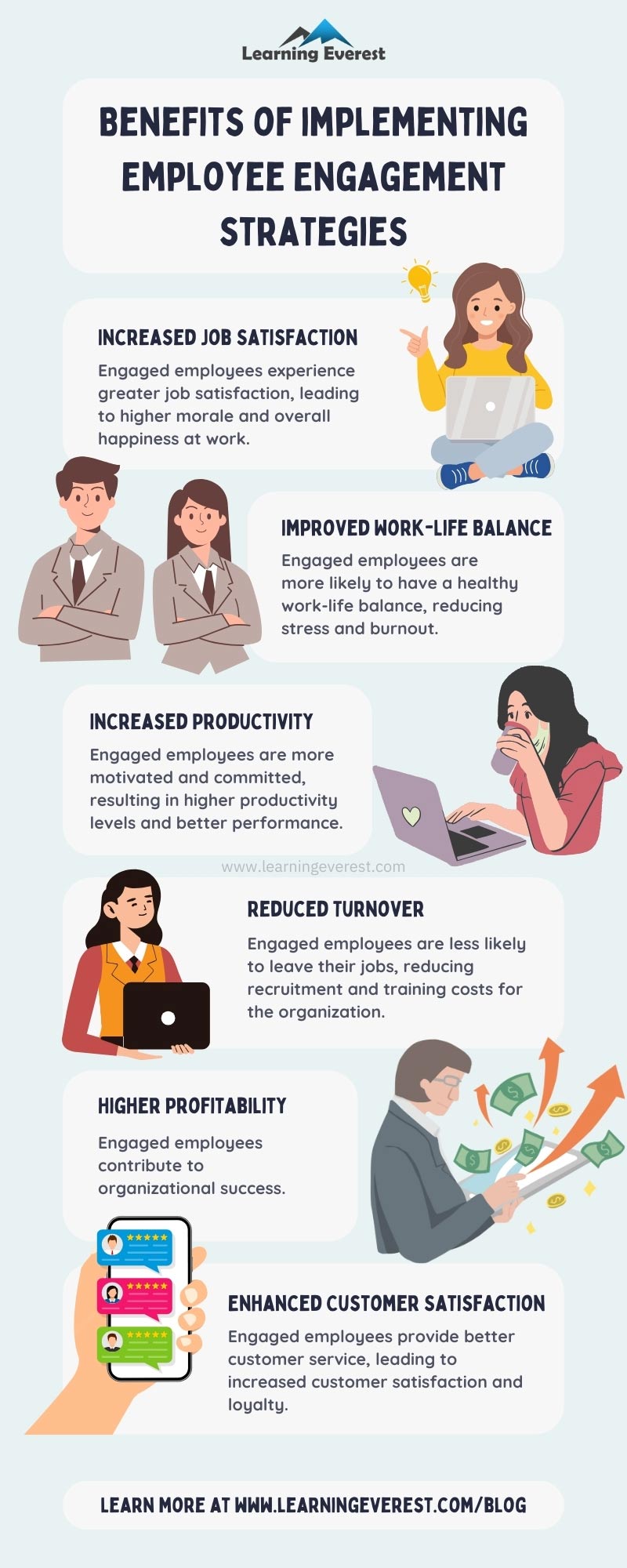Employee engagement strategies are a workplace approach to ensure that employees are committed to the business goals and values. Employee engagement strategies encourage employees to bond emotionally with their company or organization. In this article, we will explore several effective employee engagement strategies.
Table of Contents
Employee engagement refers to the amount of emotional commitment and dedication employees have toward their work, organization, and goals. Engaged employees are enthusiastic about their jobs, feel a sense of purpose, and are motivated to contribute their best efforts to help the company succeed. This often results in higher productivity, better job satisfaction, and lower turnover rates.
Employee engagement metrics that directly or indirectly measure how engaged your employees are:

Employee Engagement Strategies
7 effective employee engagement strategies for 2024
Essentially, employee engagement strategies explain how a company will keep its employees engaged and promote a positive connection between them. These might include:
1. Encourage transparent communication
A successful communication strategy helps to ensure employees are connected and engaged. Top-down, one-way communication may be accessible. But it’s two-way, transparent communication that is key. And when the workforce is remote, it’s essential to establish guidelines for remote work. Make two-way communication possible. Use your annual employee engagement survey to capture anonymous feedback and guide your decision-making. Consider shorter, more frequent pulse surveys to check in and know if messages have landed correctly.
Encourage two-way communication in meetings. Set guidelines and encourage employees to participate, especially when they’re remote. If employees are hesitant to interact, ask them for input. Set aside time for casual dialogue. Leave time at the start of each meeting to check in with people. Allow them to catch up and share what’s going on.
2. Goal alignment
Connecting employees to a larger purpose can significantly enhance engagement. This involves clearly communicating the company’s mission and values and demonstrating how each employee’s work contributes to these goals. Furthermore, involving employees in decision-making processes, social responsibility projects, and community engagement initiatives can instill a sense of ownership and pride in their work.
When your employees understand the impact of their contributions, they are more engaged and committed to their roles and the company. Engaged employees are more productive, innovative, and customer-oriented. High levels of employee engagement also contribute to lower turnover rates, reduced absenteeism, and improved organizational performance.
3. Recognition of the achievements
Recognition and appreciation have always been at the heart of employee engagement. And this goes beyond the occasional “Employee of the Month” award. Implementing a culture of continuous, real-time recognition can have a profound impact. This includes peer-to-peer recognition platforms, shout-outs in company meetings, and personal notes of thanks from management. Such gestures make employees feel valued and acknowledge their contributions to the company’s success.
4. Offering opportunities to grow
A commitment to employee development is a commitment to the future of your business. Personalized career development plans, ongoing education, skill-building opportunities, and mentorship programs are key to keeping employees engaged and invested in their roles. This approach not only aids in retaining talent but also ensures that your workforce evolves alongside technological advancements and industry shifts. Employees who feel their growth is supported are more likely to be motivated and committed to their employer.
5. Emphasizing authentic leadership
Successful leadership plays a crucial role in employee engagement within an organization. When leaders effectively lead their teams, it creates a positive work environment, fosters trust, and motivates employees to perform at their best. Effective leadership provide opportunities for professional growth and development. They recognize and utilize their employees’ skills and strengths, offering challenges and learning opportunities that contribute to personal and career advancement.
Additionally, leadership sets the tone for the overall work culture. Leaders who promote a positive and inclusive environment where diversity and collaboration are valued create a sense of belonging and camaraderie among employees. This promotes positive relationships, teamwork, and mutual support, leading to high levels of employee engagement and job satisfaction.
6. Encouraging feedback
Cultivating a culture of open and constructive feedback is pivotal for enhancing employee engagement. Feedback is a mirror, reflecting an employee’s performance back to them. When this reflection is one that highlights strengths and achievements, it can do wonders for professional development and team cohesion.
Josh Sloan, a People Scientist & Data Lab Lead at Culture Amp, describes:
“Feedback doesn’t have to be when you’re sitting down for a 1-on-1 meeting. It’s valuable to get feedback (especially when it’s positive) at any time. It’s like when you get a present on a day that’s not your birthday – it’s extra special because it’s unexpected.”
Feedback can include:
- Employee performance conversations (e.g., an annual performance review)
- Formally scheduled or highly structured meetings/events
- Regular one-on-one conversations between employees and managers
- Employee surveys (e.g., employee engagement surveys, 360° or multi-rater assessments, employee lifecycle checkpoints, and training surveys)
- Casual interpersonal interactions (e.g., water cooler chats)
- In-the-moment conversations or recaps
- Group-based settings like ‘lunch & learns’
- Peer-to-peer or employee-to-manager events
- Requested or unsolicited events
By actively seeking and valuing their insights, we not only acknowledge their significance within the organization but also empower them to take ownership of their contributions. This significantly boosts morale and drives everyone towards excellence.
7. Prioritizing health and well-being
The emphasis on employee well-being has been growing, and it’s an integral part of employee engagement strategies. Comprehensive well-being programs that include mental health support, stress management workshops, fitness memberships, and health screenings demonstrate a company’s commitment to its employees’ overall health. Additionally, promoting a healthy work-life balance and providing resources for mental health not only supports employees’ well-being but also enhances productivity and engagement.
Moreover, employees should feel respected and valued for their unique perspectives and experiences. An environment where diversity is celebrated is one where creativity and innovation flourish, driving employee engagement and business success.
So, what are you waiting for? Empower your team today!
Implement these proven employee engagement strategies to enhance your organization’s performance and culture.
To learn more, schedule a meeting today!
Infographic

Benefits of Implementing employee engagement strategies
Knowledge Check!
Frequently Asked Questions (FAQs)
Q: What is employee engagement?
A: Employee engagement refers to the emotional commitment and dedication employees have toward their work, organization, and goals.
Q: Why is employee engagement important?
A: High levels of employee engagement contribute to increased productivity, lower turnover rates, and higher profitability. Engaged employees are more motivated, contribute to a positive work culture, and help the organization achieve its goals.
Q: Can employee engagement impact customer satisfaction?
A: Yes, there’s a link between employee engagement and customer satisfaction. Engaged employees are enthusiastic about their jobs, feel a sense of purpose, and are motivated to contribute their best efforts to help the company succeed.





